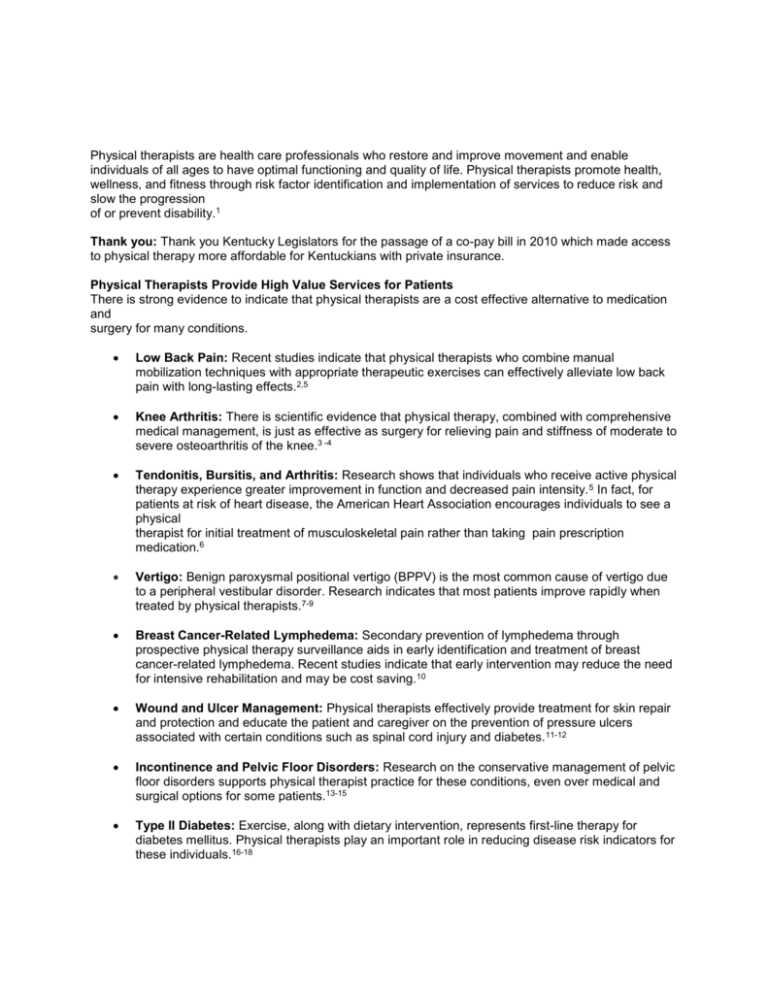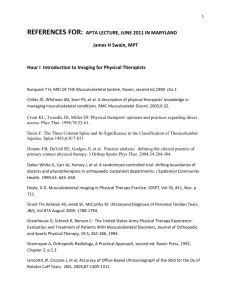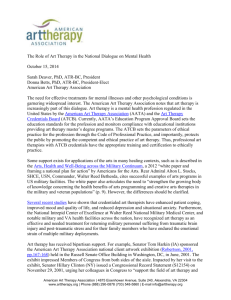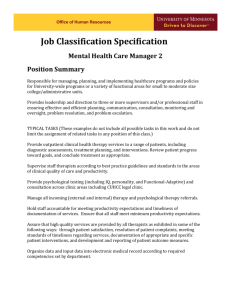Value of Physical Therapy - Kentucky Physical Therapy Association
advertisement

Physical therapists are health care professionals who restore and improve movement and enable individuals of all ages to have optimal functioning and quality of life. Physical therapists promote health, wellness, and fitness through risk factor identification and implementation of services to reduce risk and slow the progression of or prevent disability.1 Thank you: Thank you Kentucky Legislators for the passage of a co-pay bill in 2010 which made access to physical therapy more affordable for Kentuckians with private insurance. Physical Therapists Provide High Value Services for Patients There is strong evidence to indicate that physical therapists are a cost effective alternative to medication and surgery for many conditions. Low Back Pain: Recent studies indicate that physical therapists who combine manual mobilization techniques with appropriate therapeutic exercises can effectively alleviate low back pain with long-lasting effects.2,5 Knee Arthritis: There is scientific evidence that physical therapy, combined with comprehensive medical management, is just as effective as surgery for relieving pain and stiffness of moderate to severe osteoarthritis of the knee.3 -4 Tendonitis, Bursitis, and Arthritis: Research shows that individuals who receive active physical therapy experience greater improvement in function and decreased pain intensity. 5 In fact, for patients at risk of heart disease, the American Heart Association encourages individuals to see a physical therapist for initial treatment of musculoskeletal pain rather than taking pain prescription medication.6 Vertigo: Benign paroxysmal positional vertigo (BPPV) is the most common cause of vertigo due to a peripheral vestibular disorder. Research indicates that most patients improve rapidly when treated by physical therapists.7-9 Breast Cancer-Related Lymphedema: Secondary prevention of lymphedema through prospective physical therapy surveillance aids in early identification and treatment of breast cancer-related lymphedema. Recent studies indicate that early intervention may reduce the need for intensive rehabilitation and may be cost saving.10 Wound and Ulcer Management: Physical therapists effectively provide treatment for skin repair and protection and educate the patient and caregiver on the prevention of pressure ulcers associated with certain conditions such as spinal cord injury and diabetes. 11-12 Incontinence and Pelvic Floor Disorders: Research on the conservative management of pelvic floor disorders supports physical therapist practice for these conditions, even over medical and surgical options for some patients.13-15 Type II Diabetes: Exercise, along with dietary intervention, represents first-line therapy for diabetes mellitus. Physical therapists play an important role in reducing disease risk indicators for these individuals.16-18 The Right Care for the Right Patient at the Right Time In a 2011 study of 63,000 episodes of physical therapy care, researchers found that self-referred patients had fewer PT visits and lower physical therapy costs and lower use of related health care services such as diagnostic testing and injections.19 Recent studies demonstrate that physical therapists have higher levels of knowledge about managing musculoskeletal conditions than most physician specialists except for orthopedists.2 Early treatment of musculoskeletal injuries results in improved outcomes and reduced costs.TBA References 1Today’s Physical Therapist: A Comprehensive Review of a 21st Century Health Care Profession. Alexandria, VA: American Physical Therapy Association; 2011. 2Childs JD, Whitman JM, Sizer PS, Pugia ML, Flynn TW, Delitto A. A description of physical therapists' knowledge in managing musculoskeletal conditions. BMC Musculoskeletal Disorders 2005, 6:32 doi:10.1186/1471-2474-6-3. Accessed at http://www.biomedcentral.com/1471-2474/6/32. 3Kirkley A, Birmingham, TB, Litchfield RB, et al. A Randomized Trial of Arthroscopic Surgery for Osteoarthritis of the Knee. The New England Journal of Medicine. 2008;359:1097-1107 4Deyle GD, Henderson NE, Matekel Rl, Ryder MG, Garber MB. Effectiveness of manual physical therapy and exercise in osteoarthritis of the knee. Annals of Internal Medicine 2000; 132:3. 173-181. 5Fritz JM, Cleland JA, Speckman M, Brennan G, Hunter SJ. Physical Therapy for Acute Low Back Pain: Associations With Subsequent Healthcare Costs. Spine. 2008;33(16):1800-1805. 6Elliott MA, Bennett JS, Daugherty A, Furberg C, Roberts H, Taubert KA. Use of Nonsteroidal Antiinflammatory Drug. Circulation. 2007:115:1634-1642 7Brandt T, Daroff RB. Physical therapy for benign paroxysmal positional vertigo. Arch Otolaryngol. 1980;106:484-485. 8Bhattacharyya N, Baugh RF, Orvidas L, et al. Clinical practice guideline: benign paroxysmal positional vertigo. Otolaryngol Head Neck Surg. 2008;139:S47-S81. 9Helminski HO, Zee DS, Janssen I, Hain T. Effectiveness of particle repositioning maneuvers in the treatment of benign paroxysmal positional vertigo: a systematic review. Phys Ther. 2010;90:663-678. 10Stout NL, Pfalzer LA, Springer B, Levy E, et al. Breast cancer-related Lymphedema: comparing direct costs of a prospective surveillance model and a traditional model of care. Phys Ther. 2012;92:152-163; published ahead of print. 11Guihan M, Hastings J, Garber SL.Therapists’ role in pressure ulcer management in persons with spinal cord injury. J Spinal Cord Med.2009;32(5):560-7. 12 Lemaster JW, Mueller MJ, Reiber GE, et al. Effect of weight-bearing activity on foot ulcer incidence in people with diabetic peripheral neuropathy: feet first randomized controlled trial. Phys Ther. 2008;88:1385–1398 13Burgio KL, Locher JL, Goode PS. Combined behavioral and drug therapy for urge incontinence in older women. J Am GeriatricsSociety.2000;48:370-374. 14Balmforth JR, Mantle J, Bidmead J, Cardozo L. A prospective observational trial of pelvic floor muscle training for female stress urinary incontinence. BJU International.2006;98,811-817. 15Williams KS, Assassa RP, Gillies CL, Abrams KR, Turner DA, et al. A randomized controlled trial fo the effectiveness of pelvic floor therapies for urodynamic stress and mixed incontinence. . BJU International.2006;98,1043-1050. 16Chen CN, Chuang LM, Wu YT. Clinical measures of physical fitness predictinsulin resistance in people at risk for diabetes. Phys Ther. 2008;88:1355–1364. 17Turcotte LP, Fisher JS. Skeletal muscle insulin resistance: roles of fatty acid metabolism and exercise. Phys Ther. 2008;88:1279– 1296 18Gulve EA. Exercise and glycemic control in diabetes: benefits, challenges,and adjustments to pharmacotherapy. Phys Ther. 2008;88:1297–1321 19Pendergast J, Kliethermes Sa, Freburger JK, Duffy PA. A comparison of health care use for physician referred and self-referred episodes of outpatient physical therapy. Health Serv Research. Published ahead of print September 23, 2011. DOI: 10.1111/j.14756773.2011.01324x.








